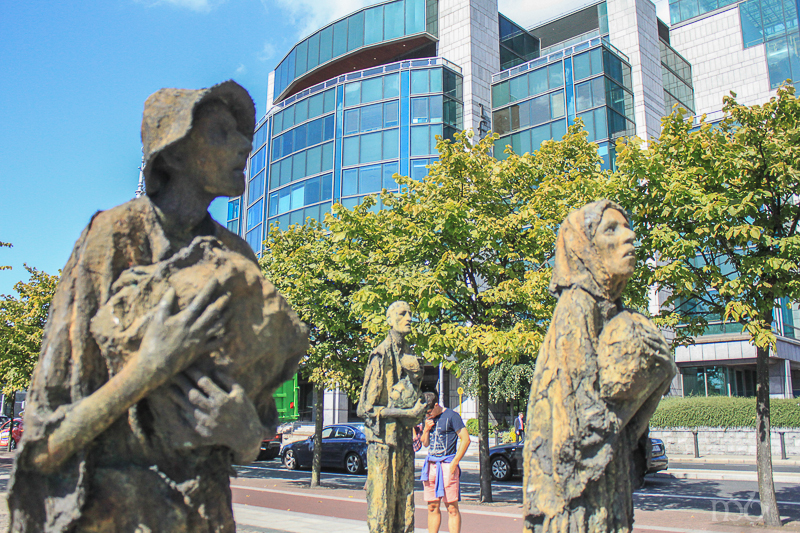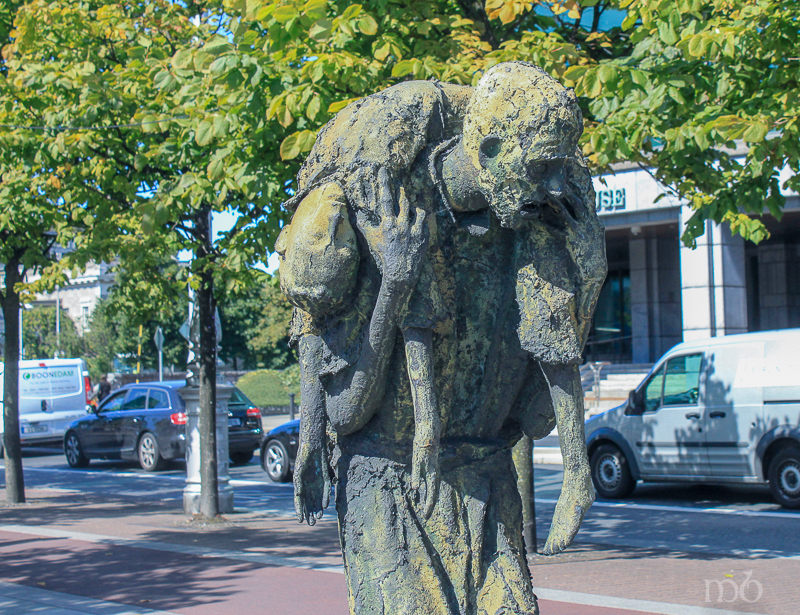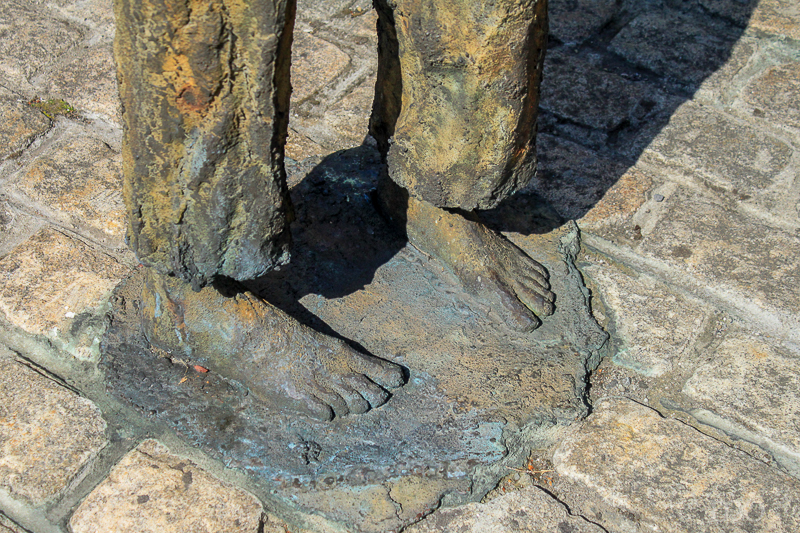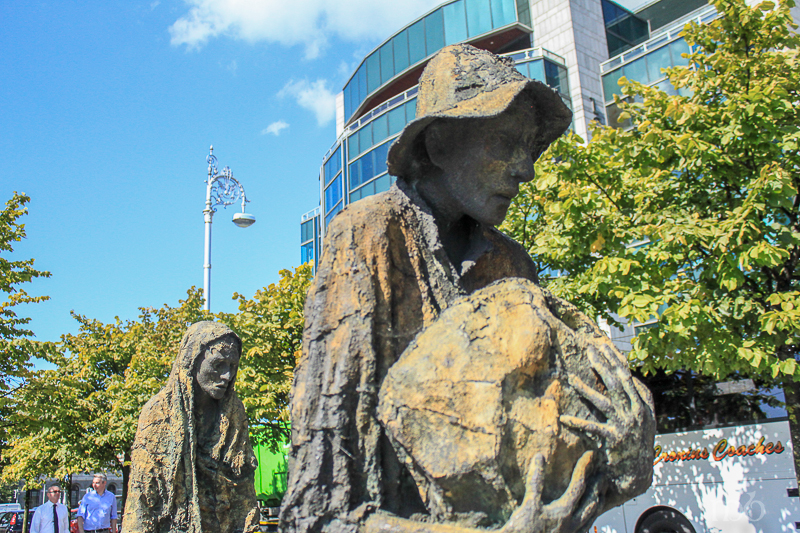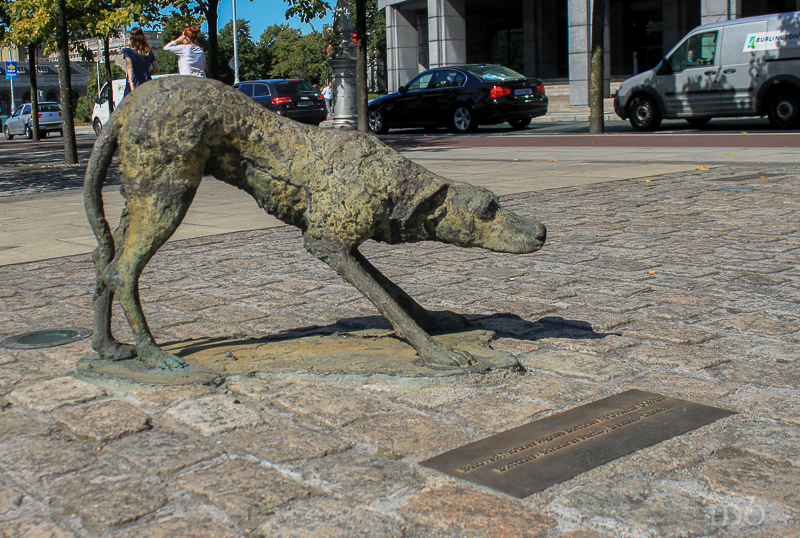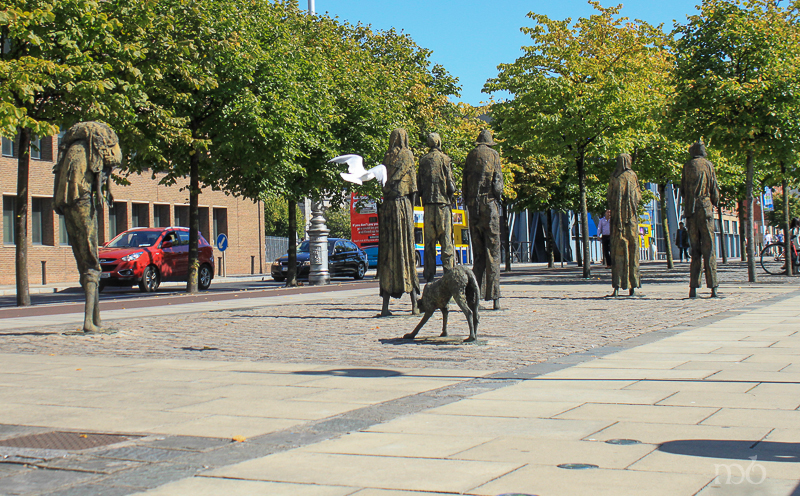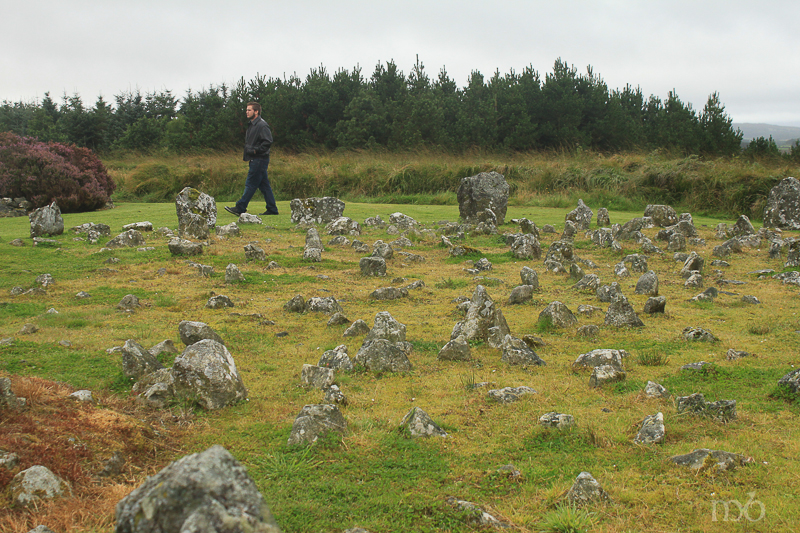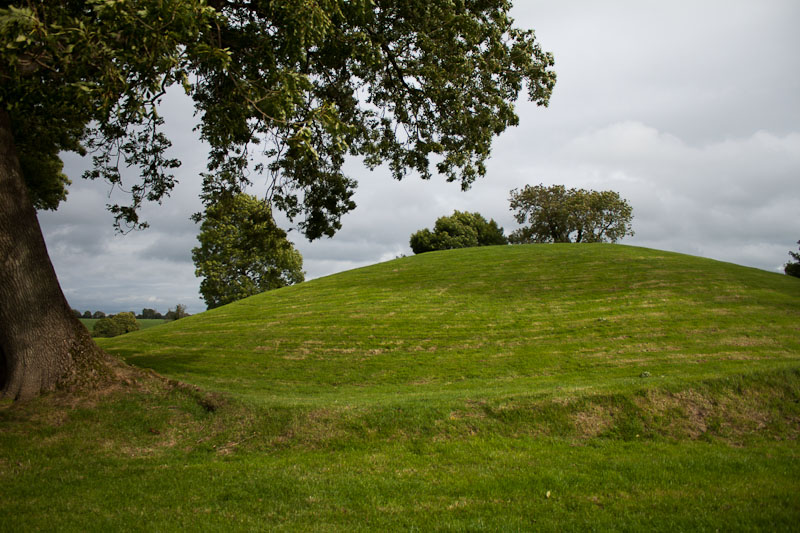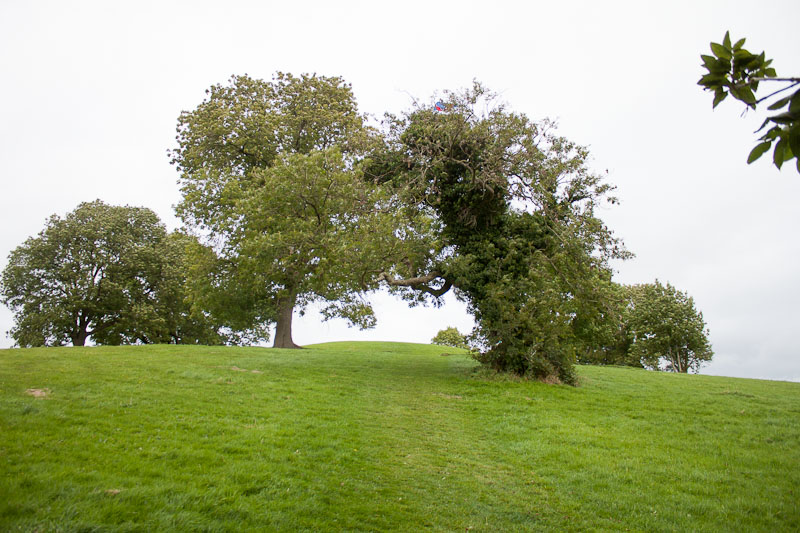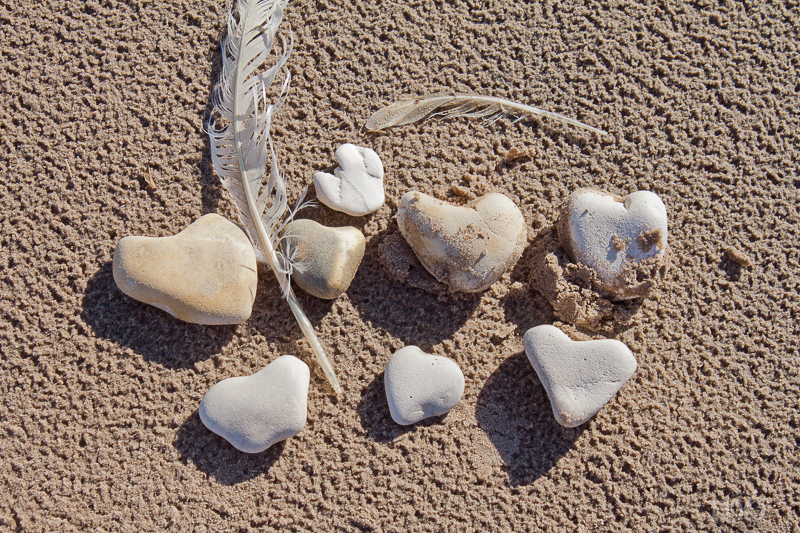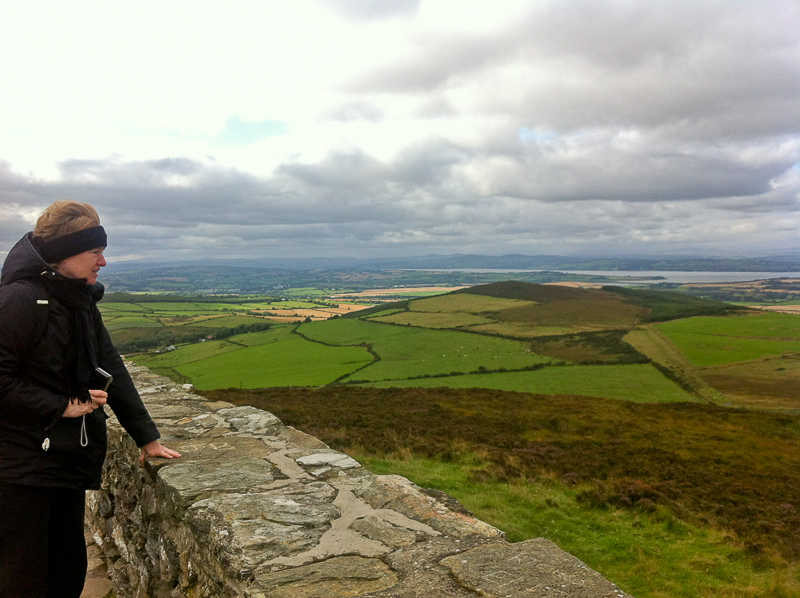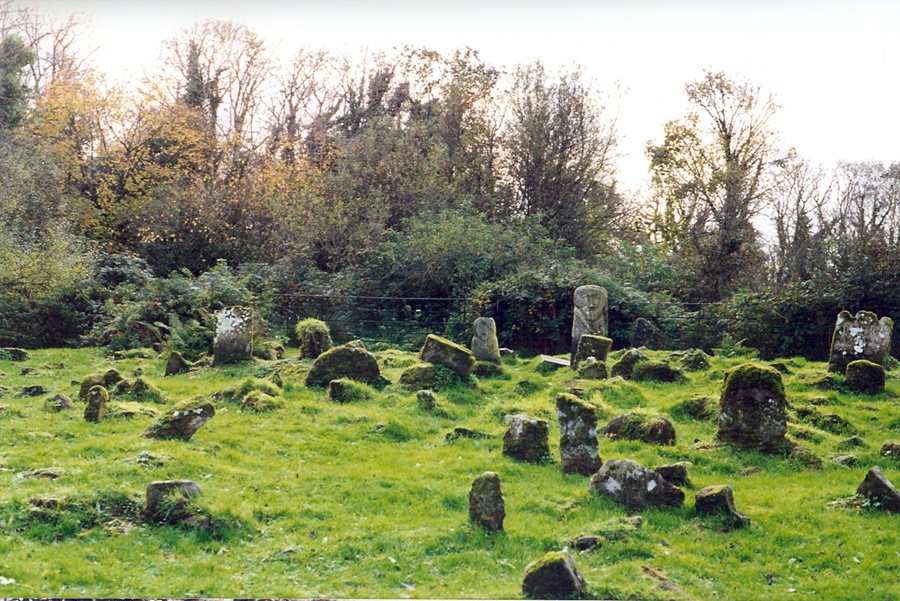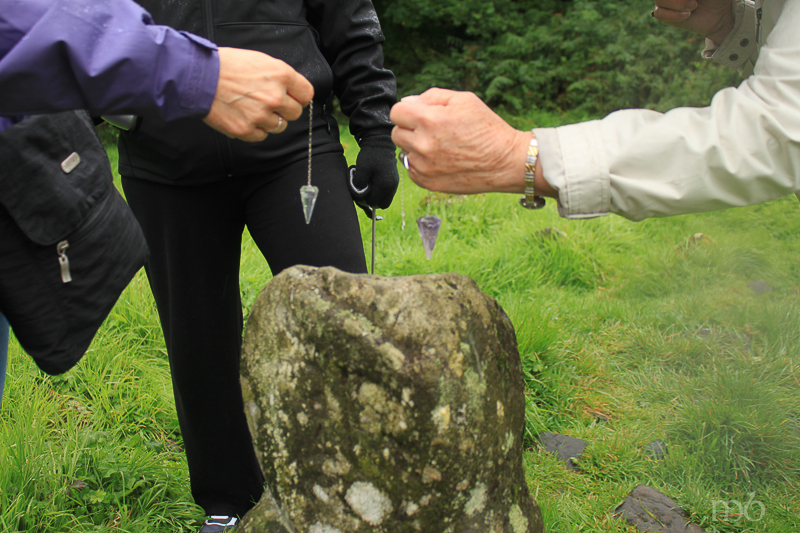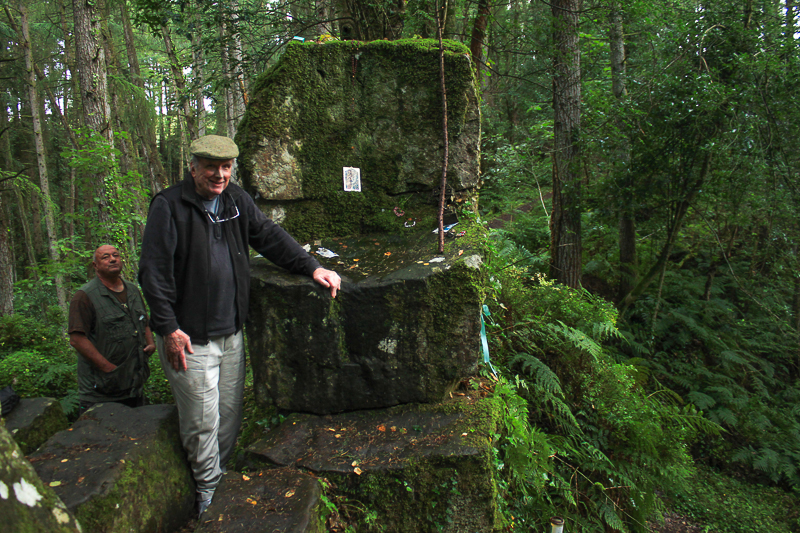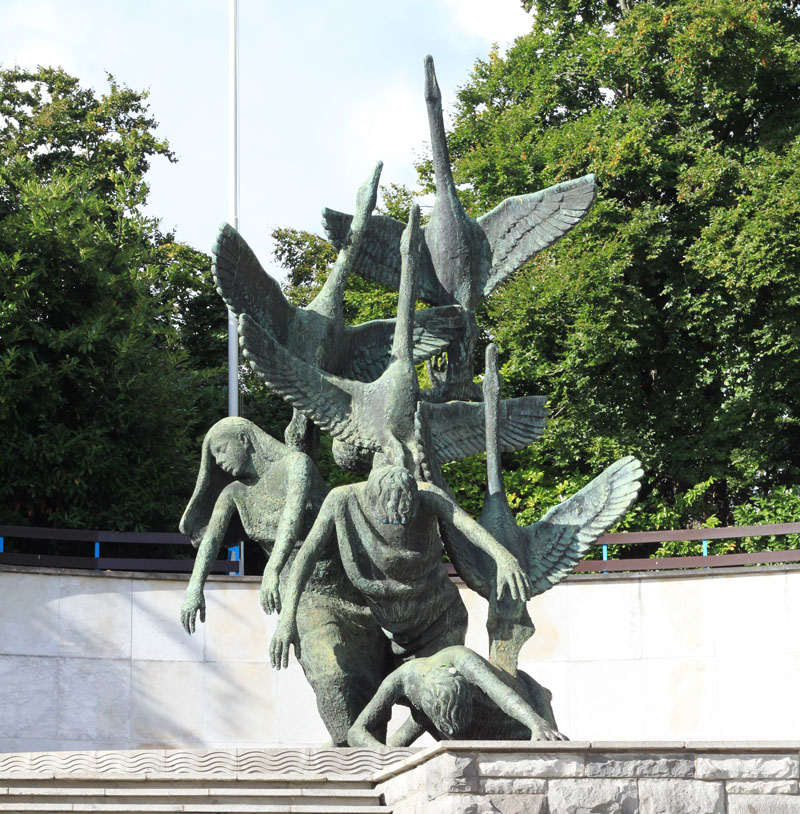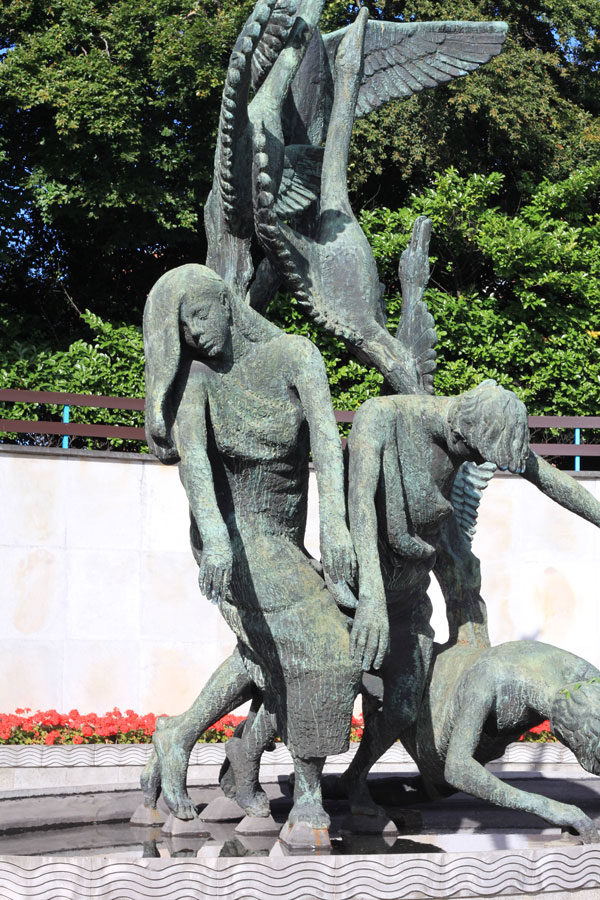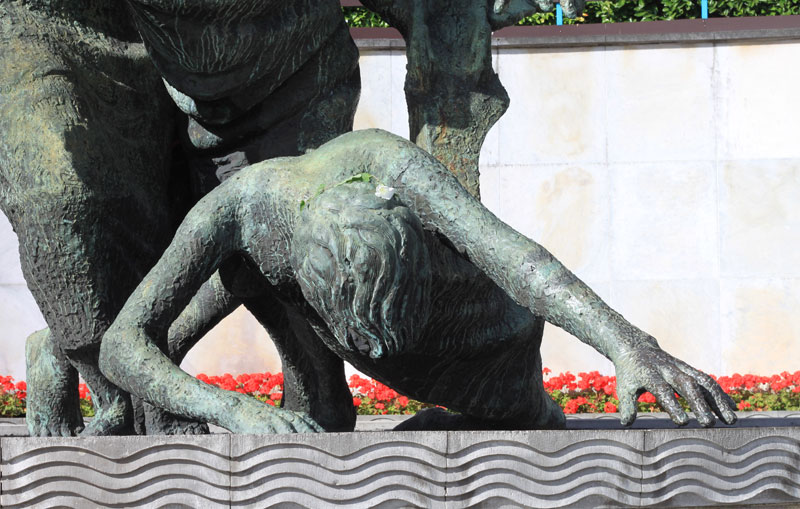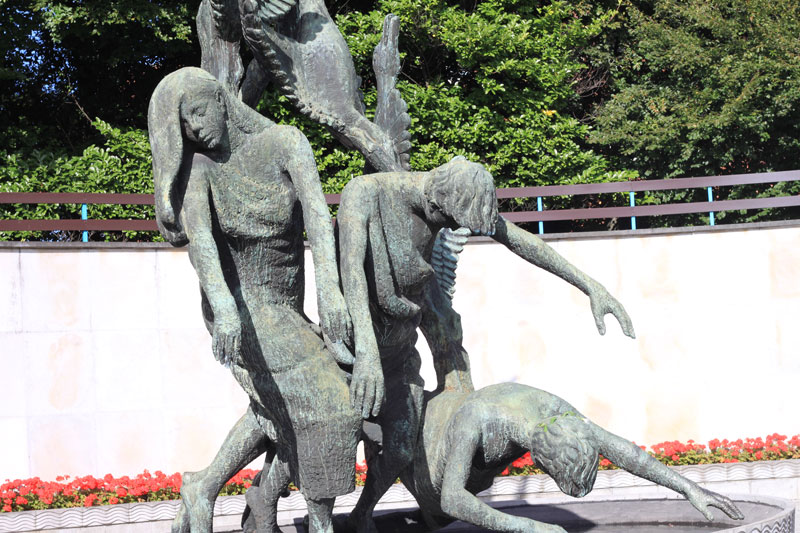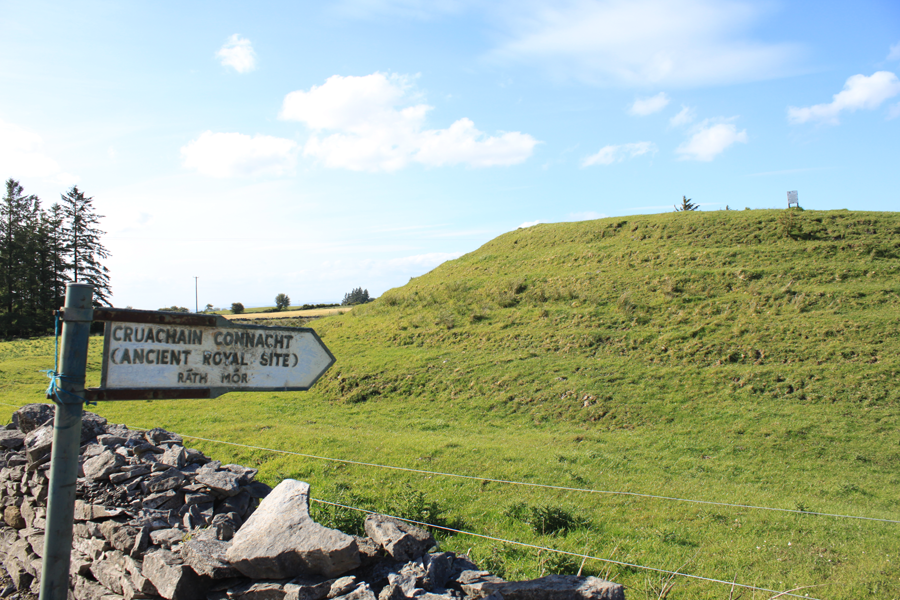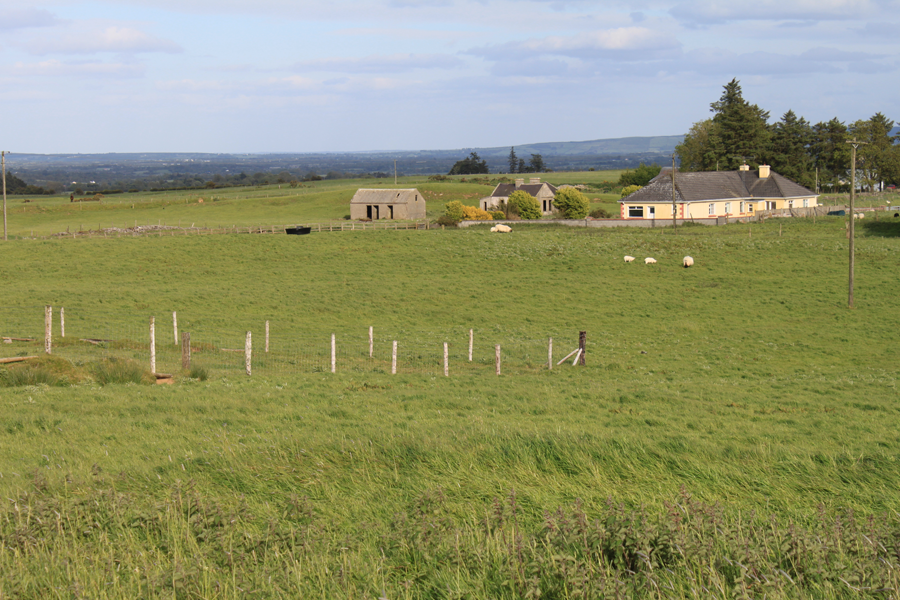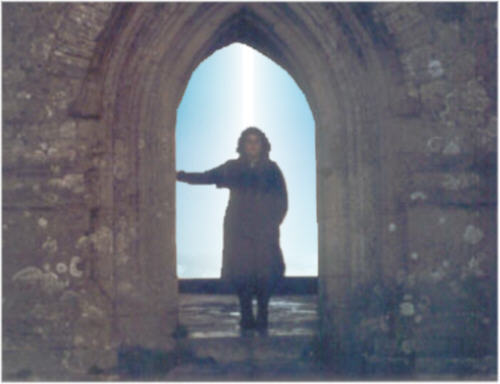Famine Memorial in Dublin – Walking in Two Worlds
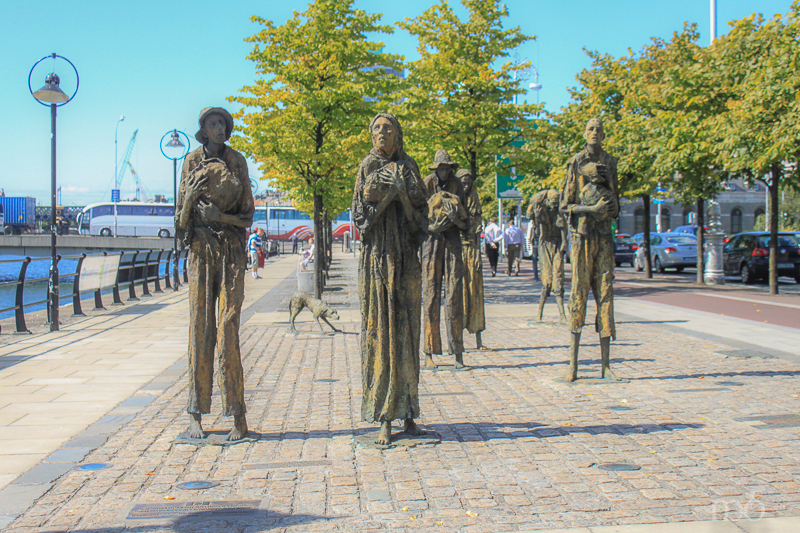 Of all the Famine Memorials I’ve seen in Ireland, the one in Custom House Quay in Dublin’s Docklands is the most moving. Life-size sculptures of gaunt, listless peasants stand almost as if in slow motion … wandering down the quay.
Of all the Famine Memorials I’ve seen in Ireland, the one in Custom House Quay in Dublin’s Docklands is the most moving. Life-size sculptures of gaunt, listless peasants stand almost as if in slow motion … wandering down the quay.
If ever there was a depiction of “walking in two worlds” it here.
One world reflects the current pulse of Dublin. Business people, tourists, and cyclists move along this path on the north side of the River Liffey at a quick pace. Their intent is focused. Even those sitting on benches are texting, or chatting on the phone, or reading. Few take notice the bronze faces and bodies – frozen in place.
The Other world is the world of the famine walkers. The world of 1845 when Great Hunger began. The walkers move quietly through the chaos of busy Dublin, slowly and deliberately. They plead for help, for food, for shelter from those who have plenty, but are are turned away or ignored…. treat like bothersome pests.
They begged the world to notice them then. They beg the world to notice them now.
When the world looked away, they lost their homes, their children died, their families crumbled. They starved.
Now they are a memory that moves through the veil of time onto Custom House Quay so that we who have much, might be moved.
One of the first Famine voyages carrying the starving Irish to new lives in America left from the this place. The ship was named Perseverance. It sailed on St. Patrick’s Day in 1846 and landed in New York two months later.
The bronze figures were designed and crafted by Dublin sculptor Rowan Gillespie, and they were presented to to the City of Dublin in 1997.
Our guests on Thin Places tours in 2014 will visit this Memorial and a few others in Dublin.
7 Sites in Northern Ireland that Feed the Soul
I remember visiting Northern Ireland in the days when the military occupied the border equipped with machine guns and combat gear. I loved the north just as much then as I do now that the army, barbed wire and weapons are gone and a quiet peace has settled over the land. It’s a rugged, raw and ancient landscape that isn’t changed by external forces. Battles come and battle go, but the land and its sacred places remain unmoved and unchanged.
The North is my favorite region probably because the bones of the old landscape still peek through the sod without having to fight massive motorways and residential developments for attention. The ancients knew the energy was powerful here, and they marked many of their sacred places. While some markings have fallen away, the energy still lives. It continues to nourish the human spirit today just as it has for thousands of years.
Sadly, most tourists in the north pass by these special places not realizing that just off the road they’re driving on are stopping places where the traveler can walk in two worlds at once. Here are seven of my favorites in the North. You can’t approach this thin places and not be moved.
BEAGHMORE STONE CIRCLES – Co. Tyrone
I’m an earth energy novice. Like most common people, I can tell when a place has a sacred feel, but I can’t feel the energy move through the stones and emanate from earth the way some of my friends can. But Beaghmore radiates energy that even I can feel. It’s palpable.
Beaghmore is a series of seven stone circles set in a clearing at the edge of the Sperrin Mountains in County Tyrone. Six of of the circles are paired and one stands alone. The circles date back to 2000 BC. Artifacts excavated from the site suggest ritual activity 1000 years before that.
Two interesting things about Beaghmore – The circle that stands alone has 800 jagged stones set in the center (known as Dragon’s Teeth) and one circle has a portal to the Otherworld. In the center of the circle with the portal is a recent burn mark in the center of scorched grass and earth. It is currently being used as a ritual site.
Read more about the mystical nature of Beaghmore on Maura Brooks’ blog.
THE GIANT’S RING – Belfast
Belfast gets a ton of visitors. But how many know that just outside the city is henge monument that predates the pyramids of Egypt? A henge monument is a circular enclosure with a ditch carved out inside the ring. A henge fort is the same circular enclosure on the ditch is on the outside making it easier to defend the fort.
The Giant’s ring is a henge monument with the ring and ditch easily identified. The earth ring is about 600 feet in diameter and in the center is a slight hill crowned by a five large stones that support a large capstone. It’s believed that these stones on the hill are what remains of a neolithic passage tomb. The area is now preserved and used as a park. The visitor can do a ritual walk around the ring and then examine the stones in the center. There is actually a 3 mile defined walk of the ring and surrounds that includes a bridge that dates back to the Stone Age and a historic woodland.
There is a lovely energy here.
NAVAN FORT – Co. Armagh
I knew about Navan Fort being the legendary stronghold for the Knights of the Red Branch and the place where the goddess Macha died giving birth to her twins. Also known as “Eamhain Mhacha” or the “twins of Macha,” Navan Fort was associated with pagan ritual for years.
But what I didn’t know was that the famous mound (130 feet in diameter and about 20 feet high) had a fire ritual history. About 94 BC a wood temple supported by large oak pillars was built where the mound is and burned on the site in ritual fashion. The ruins of the temple were covered up with stone and earth creating the mound we see today. Excavation showed that soil used in the covering of the temple came from other places – some quite distant. Today people return to soak in the energy of the mound which apparently is still quite active. There is also a tradition of rolling down the mound to in order to soak in the energy of the mound whilst giving one’s own energy back to the mound.
At the base of the mound is a fairy tree, an old oak that looks much like a dragon rearing up against an enemy.
The story of Navan Fort is well told during the guided tour. For the full experience, pay the money at the Visitor’s Center and take the tour. The guides are fabulous and there is much to learn from them.
WHITEPARK BAY – Co. Antrim
Everyone knows about the great tourist sites on the Antrim Coast – the Giant’s Causeway, Dunluce Castle, Carrick-a-Rede Rope Bridge and the Bushmills Distillery. Travelers visiting these places pass right by Whitepark Bay not realizing what a mystical site they’re overlooking.
Right between the Causeway and Rope Bridge, just off the A2 is Whitepark Bay. It has a car park and solid stairway that descends to the magical beach where the sand sings.
True.
The sand on the beach is mixed with chalk from the cliff face which gives it such a fine consistency that when the wind blows a certain way (which it inevitably will) one can hear the sand “hum” with vibration. The cliffs are gorgeous and tucked into their vegetation overgrowth are the remains of passage tombs. This space in the landscape was considered sacred to the ancients. This beach is a thin place. It’s a portal, a threshold to the Otherworld. A place for thinking, for connection with your higher self. One only has to walk it to know this truth.
I collect heart shaped rocks when I travel as souvenirs from my twin granddaughters. This usually takes an hour or more to find the perfect rock shaped like a heart. At Whitepark I set out looking for two heart shaped rocks and asked my friend Maura to help thinking we could save time. Suddenly they were everywhere. Within 10 minutes we found 8.
8 … a mystical number for sure. The number that symbolizes infinity, connection to the Creator, the Cosmic Christ, the totality of the Universe. Maura kept one for herself. I brought 7 home. On sits on my desk. A daily reminder of Whitepark Bay.
GRIANÁN of AILEACH and the INISHOWEN PENINSULA – Co. Donegal
Driving the circle around the Inishowen Peninsula is at least a half-day, if not whole day commitment. But why not commit? It is some of the most spectacular driving in all of Ireland. And unlike many of the other spectacular drives (Ring of Kerry, Sally Gap, Connemara Hills, Molls Gap) it isn’t so crowded with visitors and coaches. Even in the cold and the pouring rain, the Inishowen is gorgeous. At its base on the south eastern side is Grianán of Aileach, also known as the Sun Palace.
Grianán of Aileach was the ancient royal site for northern Ui Néil from the 5th to the 12th century. The now restored cashel dates to the 3rd century and caps three concentric earth rings. The panoramic views from the cashel of the peninsula, Loughs Foil and Swilly and the city of Derry are dizzying – especially if you’re balancing yourself on the top ridge of the cashel.
There is also a tradition that the temple was built by Daghdha, the good god or god of the earth. He was known as the King of the Tuatha dé Danann, a race of supernatural beings descended from the Goddess Danu. They inhabited Ireland before the Celts. This tradition has Daghda building the fort to protect the grave of his son. A variation tells of giants building the hill and the Grianán on top a residence for the shining ones who gave birth to the children of the sídhe. All of these traditions link the hill and the fort on top with supernatural beings, to unseen energy and power and a link to the Otherworld.
BOA ISLAND & CALDRAGH CEMETERY – Co. Fermanagh
This is place every mystic should visit before he or she dies. Walking into Caldragh is like passing into another world. It’s an ancient cemetery on Boa Island set on the north shore of Lough Erne. It is surrounded by hazel woods with a fairy tree at the entrance. The ground is lumpy due to all the old graves, marked with jagged stones now covered by grass. There are also new graves but no church indicating this particular spot is still a place of sacred reverence for the local community.
Caldragh Cemetery is most famous for its Janus figure, a stone figure likely dating to the 4th or 5th century that has a face carved on both sides (thus the name Janus who was the Roman god of two faces). The Janus stands about 4 feet high and many archaeologists and mystics have guessed at what the two-faced figure represents, but it’s all speculation. There is a great energy in the stone. A dangling a pendulum above this stone spins quickly, even for the beginner. And the quiet soul will find a peaceful rest and easy connection to the Otherworld here.
Poet and Northern Ireland native, Seamus Heaney memorialized the Janus figure in a poem.
JANUARY GOD
Then I found a two faced stone
On burial ground,
God-eyed, sex-mouthed, it’s brain
A watery wound.
In the wet gap of the year,
Daubed with fresh lake mud,
I faltered near his power —-
January God.
Who broke the water, the hymen
With his great antlers —-
There reigned upon each ghost tine
His familiars,
The mothering earth, the stones
Taken by each wave,
The fleshy aftergrass, the bones
Subsoil in each grave.
For me Caldragh is much like the Rock of Cashel. No matter how many times I visit, I always want to return.
ALTADAVEN WOOD & ST. PATRICK’S CHAIR – Co. Tyrone
Altadaven Wood or Favour Royal Forest is an old wooded area bisected by an ancient road known as the Sliabh Beagh Way which snaked through Counties Tyrone, Fermanagh and Monaghan. On that road is the Demon Cliff where there is a large stone throne-like chair straddling a narrow space on the road. The chair, and the well below it are now known as St. Patrick’s Chair. Legends tell of this being an ancient druidic site that St. Patrick came upon while walking the Sliabh Beagh Way. When he saw the pagan ritual being performed he raised his crozier and cast the demons (druids) off the cliff and claimed the sacred site for Christ.
The forest is one of those great “edges” in the world where one crosses over into something upon entry. It’s thick and the mystical walk to the chair is deeply shaded by fir trees and lined with ivy, holly and fern. And suddenly you’re at the chair. Tokens left behind are reminders of other pilgrims who walk to the chair with intentions in their hearts. Some say that if you sit in the chair and make a wish, your wish will come true within one year unless you tell someone. It’s worth the walk.
All of the sites mentioned above are featured on our DISCOVER THE NORTH mystical tour of Ireland’s thin places.
Remembering Heroes and the Children of Lir
Lir was the Lord of the Sea, in the days of the Tuatha de Danann. He had four children – a daughter, Fionnualla and three sons – Aodh and twins Conn and Fiachra. His wife died when the children were still young and Lir married Aoife a woman with magical powers.
Aoife became jealous of the love Lir had for his children and they for him. She also resented how much the children missed their mother. She tried in vain to get a servant to kill the children, thenclost her nerve when she herself set out to kill the children. So she cast a spell on them. She turned the children into the most beautiful swans ever seen, and told them they would be forced to spend nine hundred years as swans – three hundred on Lough Derravaragh, three hundred on the Straits of Moyle and three hundred on the Isle of Inish Glora. They would, however be allowed to keep their voices and as swans they made the most mystical, magical music in all of Ireland.
To end the spell the children would have to hear the bell of the new God, and a holy man would have to ring it.
For three hundred years they lived on Lake Derravaragh and then they flew to the Straits of Moyle and spent another three hundred years. By this time, St. Patrick was converting all of Ireland, and Ireland had accepted this one true God above all gods.
When the last three hundred years of exile on the Isle of Inish Glora were up, they met a man named Mochua. They asked him if he was a holy man and he said he was. He asked them if they were the children of Lir. He had heard about these beautiful swans who sang magically being the cursed children of Lir. They responded that they, in fact were the children of Lir. Mochua set about to make a bell to ring to set the children free.
Just when the bell was finished, the King of Connaught came to the Isle of Inish Glora demanding to take the swans to his castle because his wife was captivated by their beautiful singing and wanted to own them so she could hear that singing whenever she liked. The King was prepared to take them by force if necessary. Just as he began to round up the swans, Mochua rang the bell with fierce enthusiasm. A mist formed around the swans and a great white light seemed to illuminate them suspending them in the air.
The swans began to rise and then fade, and below them the limp forms of four children appeared on the ground. The human bodies of Fionnualla, Aodh, Fiachra and Conn aged 900 years in a few minutes… and they died, ending the race of the Tuatha de Danann.
The spirits of the children of Lir were united with their beloved parents and their presence is felt today by those who choose to remember them.
 The Garden of Remembrance in Dublin was built in memory of all those who gave their lives fighting in the cause for Irish freedom. The memorial is built on the site where leaders of the 1916 Easter Uprising were held overnight before they were taken to the Kilmainham Gaol to be executed. The dominant feature in the garden is a sculpture representing the Children of Lir who had to live in exile for 900 years, similar to the 900 years of oppression the Irish suffered under British occupation.
The Garden of Remembrance in Dublin was built in memory of all those who gave their lives fighting in the cause for Irish freedom. The memorial is built on the site where leaders of the 1916 Easter Uprising were held overnight before they were taken to the Kilmainham Gaol to be executed. The dominant feature in the garden is a sculpture representing the Children of Lir who had to live in exile for 900 years, similar to the 900 years of oppression the Irish suffered under British occupation.
A reflecting pool has images of swords, spears, shields an implements of warfare painted on the bottom. In the Celtic tradition clans who did battle cast their weapons into the sea or a lake after the battle is over to symbolize the end of hostilities.
The Garden of Remembrance is a thin place.
Thin Places: Irish Gateways to the Otherworld
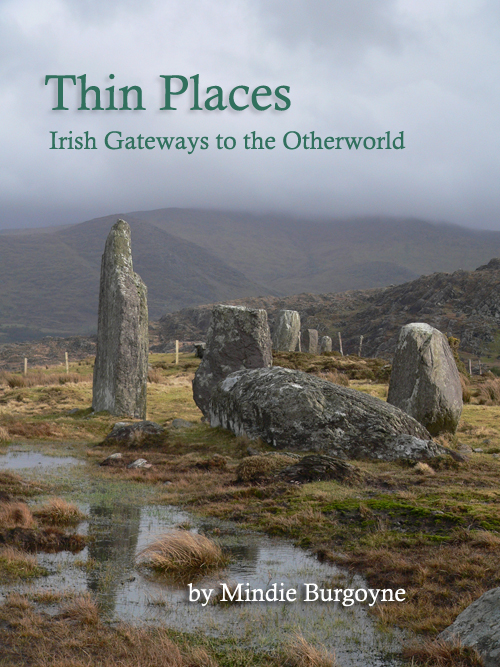 Thin Places: Irish Gateways to the Otherworld, by Mindie Burgoyne will published in 2015.
Thin Places: Irish Gateways to the Otherworld, by Mindie Burgoyne will published in 2015.
The book is approximately focuses on places where the veil between this world and the eternal world is thin. These could be places with a powerful spiritual energy – places that were marked sacred by people who lived centuries ago – places where people still go to feed the spirit and the mind.
The book includes commentary about 33 sites in Ireland – some familiar such as Glendalough, the Hill of Tara, Newgrange, Croagh Patrick, Glencolumkille, the Aran Islands and Carrowkeel, and some more obscure like Ardboe, St. Berrihert’s Kyle, Cashelkeelty Stone Circle, Ardmore and Doolough. Additionally, the book will highlight beliefs and practices regarding thin places such as earth energies, rituals and the connection between sites, geography and the Celtic year.
Mindie Burgoyne has been traveling to Ireland and researching thin places for 20 years. This book is an accumulation of the most mystical places she’s been. It allows the reader to go on a vicarious journey – walking in two worlds.
RESERVE YOUR COPY – NO PURCHASE UNTIL PRINTED
Those interested in obtaining a signed copy one of the first thousand books printed should email tours@travelhag.com with your request. Include your NAME and ADDRESS and email where you’d like to receive notification of publication date. You will be among the first to receive signed copies.
No personal contact information entered on the form will be shared. This is strictly for those interested in reserving one of the first copies of Thin Places.
What is a Thin Place? Mike Croghan Answers
Mike Croghan who runs Rathcroghan Tours gave some beautiful commentary when we asked him “What is a Thin Place?” The 2:57 video below is part of that response (more to follow in another post).
Rathcroghan is the ancient royal capital of Connacht. It’s landscape is covered with mounds and stones and lines of energy. Mike was our private guide for the Rathcroghan site on the Thin Places tour of the West in 2012.
The wind was bit loud in the video, so a transcript of what Mike said is written below the video.
Transcript of Mike Croghan’s commentary:
A thin place, as you know yourself, is a very loose term .. for a place that would allow people to make a connection. It could be a place between the earth and the vaults of the skies. It could be a place between the earth and the Other world.
It’s a place where the deities and the people of the Other world at special times of the year can make their way through into our realm, but also, at that same time it’s an opportunity for us to travel to the Other world. And it’s a time where you can make a direct connection with the people of the Sidhe, the people of the mounds, the ancestors.
There are a few people, a few special people who have the ability to do this wherever. For the majority of us, a thin place is an opportunity to to make that connection in a certain geographical location.
Here in Ireland we have so many thin places. We have countless thin places. The specific one that I will always mention to people is Oweynagat – the Cave of the Cats – here on Rathcroghan. It’s known as the entrance to Mother Earth. It’s known as the entrance to the Other World. And that really would really be – let’s call it an axis mundi which is a pivotal point between our world and the Other World.
Just to sum it up, a thin place is a place where you can make a connection, and a lot of the time it’s in a specific geographical location. Like I say here it might be the Cave of the Cats. It could be Keshcorran over in Sligo. It could be on Tara. It might be Uisneach. It might be one of the four royal capitals.
It’s a different place for different people.
What I would say to people out there is that if they go looking for thin places, you might find it on a map. You might just find it in your own personal space – wherever you do ritual… wherever you work.
What’s the Deal With Thin Places?
In a a phone interview last week, I was asked, “What’s the deal with thin places?” I was being interviewed by a journalist covering business, and the focus of the article was to be using social media to grow a business. But the interviewer had done some background research on me, read my blogs and seen that I write about, give lectures on, and gives tours of “thin places.”
So I gave the writer my standard answer, “thin places are places where the veil between this world and the eternal world is thin.” The look on his face said, “So?”
I continued, “Do you really want to get into this?” He said, “Why not?” I found myself regurgitating the same old stale sentences I’ve used in the past, perhaps because I assumed this business journalist had no genuine interest in the concept of mystical sites. However, his confused face betrayed his business focus and revealed a personal intrigue. He said, “Why would I want to go to a thin place?”
Hmmm. Why would he?
I offered an explanation, and soon found my raised voice and overt hand gestures revealing my passion for thin places. I tend to lose control.
My answer to “Why would I want to go to a thin place?”
We humans are physical, mental and spiritual. Our spiritual side, unlike the physical and mental side is not experienced through our five senses. All civilizations have left behind indications that they had a spiritual life, that they looked beyond the physical world and communicated with the eternal world.
If meat and veggies feed the body, and books and learning feed the mind, thin places feed the soul and help to expand the human spirit. A place with an inherent mystical quality or “thin veil” between worlds allows the person in that place to stretch and grow his or her spiritual sensitivities. These places help us pray better, contemplate on a deeper level, and “touch the other side”… manifesting the power of the eternal world inside ourselves.
Grace and spiritual blessings come easily in thin places. Insights emerge and amaze us. Answers to spiritual questions are heard. And the greatest of all spiritual endowments is magnified in thin places – inner peace.
Peace.
Worries are diminished, depression lifted, and priorities redefined when we expand our degree of inner peace, and our gratitude for simple things is amplified. Inner peace enlarges our sense that all nature is charged with divinity, a common theme over the centuries – evident in Psalm 148 and St. Francis of Assis’s Canticle of the Creatures.
Is there value in that?

Thin Places – Do we make them thin or are they inherently thin?
I’m a believer that thin places are inherently thin, and their mystical qualities draw humans to them. And though I believe that thin places exist all over the planet, I don’t believe we – that is humans – make these places thin by connecting with God there. Perhaps great acts of humans living, loving, suffering, or dying in a particular place impact the veil – thus the thinness in places like Gettysburg, Thoor Ballylee, Taj Mahal, or Skibbereen. But a thin place is what it is. In most cases, we don’t impact the degree of thinness. Keen, spiritual sensitivities help us identify these places.
I reject the idea that we create our own thin places. “Because I feel God’s presence strongly right now, this must be a thin place.” I believe that with a well exercised spirit we can enter into a spiritual state more readily – anywhere. That same exercised spirit will also be able to identify a place that is mystical and close to the eternal, and take advantage of the openness.
Blessings Come to Us in Thin Places
When the human spirit is tuned in at a thin place, communication with the eternal world flows back and forth readily and easily. Not just with God, but with the communion of saints – those that have gone before us. We all stand in the same time, in the same space. Our prayers joined with prayers of the saints makes our humble prayer stronger. Spiritual graces and insights flow. We find ourselves easily uncovering answers to the questions of the heart. We find encouragement for our sense of defeat, comfort for the losses we mourn.
I find the presence of love – the greatest power in the world – so prevalent in thin places that it is almost palpable. Love knows now barriers between worlds. It hovers in a thin place, unifying both the physical and the eternal. That overwhelming sense of the presence of spiritual love is worth the visit.
For me, these are worthy reasons for traveling to thin places.
Invite all you readers to come with us on the Thin Places Tour.
